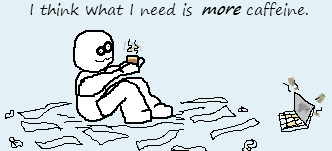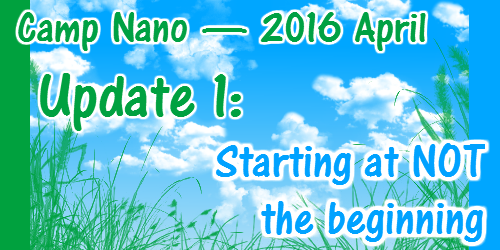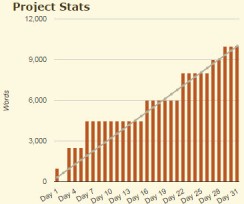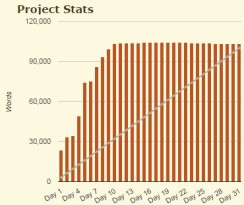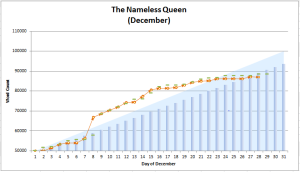Writing a book is hard. Getting an agent and getting a book published is hard.
But let’s talk about some of the tools you can use to help you along your way. Using a single giant document might not be enough. Here is a brief list of tools—both physical and electronic—that I use when I write.
One thing I learned while drafting THE NAMELESS QUEEN was that “writing” is more than just writing. It was outlining and drawing, scribbling, and flow-charting. It was ranting to my sister and friends about stupid plot holes and fighting with the default formatting inside software. It’s exporting files and tracking metrics to promote productive work. It’s talking to myself when I’m alone in my car. “Writing a Book” is really “Creating a Self-Sustaining Guide to a Million Methods of Madness.” It’s “build a world with rules and people.” It’s “design a scene with emotional weight and tension.” It’s “understand other human minds.” It’s “communicate effectively.”
How does this network of intersecting Chaos Roads relate to tools? I learned through these activities that I need an area for chaotic thinking and an area for orderly thinking. And sometimes I need one of these arenas for EACH story or project I’m working on. Sometimes I need one of those arenas for every single aspect of the writing process. I know some people who are very ritualistic about the work they do. Same place, same time every day. Same schedule. Repetition fuels them.
Repetition is great for me, too, but only in small doses. Only in shifting patterns. A routine that adapts as your needs change.
So I’ll use the same program or tool over and over again, but I’m always on the look out for when those tools stop working. After time, I find that I get less done in a certain place or with a certain program. When that happens, I pick up and move on. I try something new. If my brain is in Chaotic Thinking mode, maybe I need to go for a walk and rant to myself. If my brain is in Orderly Thinking mode, maybe I need a structured environment with a table, chairs, harsh white lighting, and no internet.
To cope with these needs, here are the physical and electronic tools I’ve used during the drafting and revising stages of my first to-be-published book.
Physical Resources & Tools
Notebooks
I have quite a few of these. I get them for presents, I buy them for fun, and I have about 72 million. Each one is used for something different, and some of them I have specifically designated for certain projects or different types of work. Here’s a list of the ones I have and use right now. Also, full disclosure, I *name* them, too. I don’t even know why. But there you are. Let’s introduce them:
- Chevryn — This is a black book that I keep in my backpack now. I used to keep it in my purse (before I got a cool new backpack), and before that it spent a few months on The Pile of Many Notebooks in my den. Chevryn is a scribble-it-down place. It is an area for Chaotic Thinking or disorganized thoughts.
- Duval — This is a smaller black book that definitely fits in my backpack and probably my coat pocket, too. It’s the On The Go notebook. I don’t like not having a notebook/pen, so this is my tag-along friend. Random scenes or ideas get scribbled here.
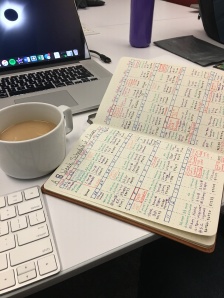 Dodd — An aptly named dot-journal, this journal is for Organized Thoughts. Sometimes you need to scribble, and sometimes you need to organize. Book writing and revising can be messy or calculating (both, really), and this is the place I go for tracking my work and keeping my thoughts orderly.
Dodd — An aptly named dot-journal, this journal is for Organized Thoughts. Sometimes you need to scribble, and sometimes you need to organize. Book writing and revising can be messy or calculating (both, really), and this is the place I go for tracking my work and keeping my thoughts orderly.- Jerald — This is an older brown journal that I used specifically for hand-writing scenes of some older manuscripts I worked on. Staring at a blank page can be daunting. When I need to work in a new place on a project when I’m stuck, I sometimes like to hand-write it. When I trunked those projects, it felt right to move on. There is no law that says you must finish a journal once you start. Which is great, because I have literally never finished writing all the way through ANY journal EVER. Points for consistency, I suppose.
Binders
In 2014, when I was planning Book 1: The Nameless Queen. In ten days, I had a partially-fledged novel plan with things like character descriptions, flowcharts for plot, drawings of thematic arcs, and hastily-drawn sketches of mapped locations. (Fun fact: there is a LOT of content in that binder that is 100% no longer applicable to the story as it is today.)
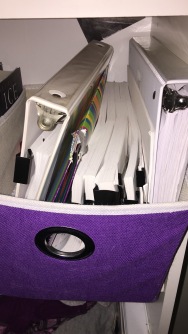 Binder One (I’ve not given these fellows any quirky names or anything), contains All Things Book 1 related. When I was at work, I’d scribble scenes on sticky notes or notepads, and I’d bring them home, type them up, and in the binder they’d go. It was a way of bringing order to chaos. It was a way to collect what I didn’t want to lose track of. (Because for real, how many times have you thought about something perfect, but by the time you get home or get to that part of the book, you’ve forgotten your Grand Plan.) I found that hand-writing or getting thoughts down in the middle of the day was necessary. Yeah, I could try to separate my 9-5 job and my Creative Brain, but your brain doesn’t always let you decide these things. And my best experience tells me that if your Creative Brain is on, let it be on. Find a way to be productive, because inspiration does not strike on a schedule.
Binder One (I’ve not given these fellows any quirky names or anything), contains All Things Book 1 related. When I was at work, I’d scribble scenes on sticky notes or notepads, and I’d bring them home, type them up, and in the binder they’d go. It was a way of bringing order to chaos. It was a way to collect what I didn’t want to lose track of. (Because for real, how many times have you thought about something perfect, but by the time you get home or get to that part of the book, you’ve forgotten your Grand Plan.) I found that hand-writing or getting thoughts down in the middle of the day was necessary. Yeah, I could try to separate my 9-5 job and my Creative Brain, but your brain doesn’t always let you decide these things. And my best experience tells me that if your Creative Brain is on, let it be on. Find a way to be productive, because inspiration does not strike on a schedule.
Binder Two is similar to Binder One, except I put a note in the cover that says “the sequel.” It has ideas and plans and characters, just like Binder One, but with all the grandness of being the second. It’s filled with mostly blank printer paper, because when you gotta flow-chart, you just gotta flow-chart.
Whiteboard
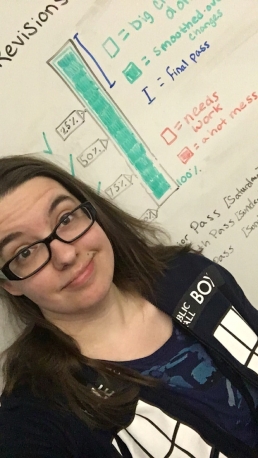
I love whiteboards. If whiteboard walls weren’t terrible for maintenance (and not super great tbh), I would live in a cube of whiteboards. I would live in a mansion built of whiteboard cubes. In my Meditation House (which–not to get off track–is a meditative house I build in my brain when I’m trying to sleep), there is specifically a room that is covered with whiteboards. And in one corner of that whiteboard, there are all the digits of pi I’ve memorized. Hmm. Okay. That was probably more insight into my psyche than you wanted. Moving right along!
I use whiteboards for making physical maps so I can get my scene/plot progressions straight. I use them for everything I use journals or printer paper for, except whiteboards have a really fast turn-over. Whiteboards are great when you need to let ideas flow fast, draw-erase, draw-erase, draw some more. Take a picture if you want it to last forever, or transfer it into an Organized Thinking location like a notebook or binder.
Corkboard
I have a corkboard that I used primarily for mapping out the scene progression through the story. I needed a visual for wrapping my brain around the order of events and to flag things when they went wrong. So I used a bunch of sticky notes and notecards, wrote down important things, and moved them around on the corkboard as needed. I’d classify this as a Bringing to Order resource.
Print It Off!
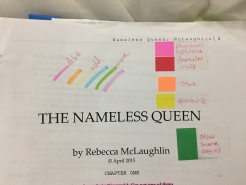 Sometimes, you just need to dig in with your hands. Having something physical lets your brain comprehend the content in a different way. That’s why writing long-hand can offer some much-need refreshment to an otherwise electronic-heavy experience. For revisions, you can break out the highlighter and sticky-tabs. For me, the sticky-tabs are particularly helpful, because it makes it easier to flip back and forth between two sections and see how much physical space certain events take.
Sometimes, you just need to dig in with your hands. Having something physical lets your brain comprehend the content in a different way. That’s why writing long-hand can offer some much-need refreshment to an otherwise electronic-heavy experience. For revisions, you can break out the highlighter and sticky-tabs. For me, the sticky-tabs are particularly helpful, because it makes it easier to flip back and forth between two sections and see how much physical space certain events take.
Hot tip: if you use different colored highlighters for different things or different types of tabs, be sure to include that information as a key (like a map legend) in the beginning!
Sticky Notes
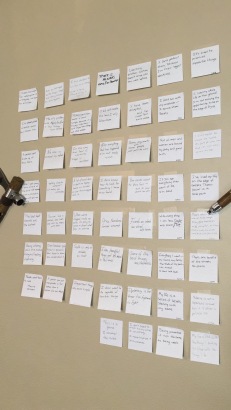
This may seem narcissistic, but I promise it isn’t. Probably. But you know how when you write a scene or a line, and it just works. It just clicks. It speaks to the themes of your story, and it rings true and good. Those moments—those lines and quotes from your book—write them down! Collect them, and post them on your wall! You can do this electronically or physically, but the important thing is to take pride when you do good work. If you find those moments and sentences that speak to the soul of your work, you need to hang on to those! Put them in a safe place where you can refer back to them. It will give you encouragement when you hit a wall. It will be a collection of milestones and accomplishments, touchstones and tokens that prove to you that you can do this. It says you are good. It says remember why you love this. I can’t tell you how many times I looked up to that wall of sticky-notes for inspiration from my past self. These things are important. So whether it’s sticky notes, a cork board, drawing directly on your wall—make sure to collect your own achievements. Be proud! Celebrate yourself!
Receipts and Other Scraps
Always. Carry. A. Pen.
This advice is a bit flexible if you always have your phone, but in my experience there isn’t much more exciting than a bolt of inspiration that strikes lightning into your bones.
When the final scene of THE NAMELESS QUEEN popped into my head, I was at someone else’s house and I did. not. have. a. freaking. pen. I scrambled about until I found a brick-colored crayon, and I scribbled out the ending on a piece of paper. The ending page of my book has hardly changed since I wrote it in crayon. Except that the first draft was written in a weird on-the-fly symbolic code.
But the advice stands! Always be ready for when your brain decides to throw you a curve ball. Whether that means scribbling on the back of receipts, the back of your hand, the back of a stranger’s hand, or that envelope on your table you’ve been meaning to recycle.
Hot tip: Be prepared for inspiration, but don’t wait for it.
Electronic
Visual Planning Programs
If you’re a visual person like me, sometimes you just need to SEE it. You need to prove to yourself it exists. Here are some of the computer software/programs I’ve used and what I’ve used them for.
InDesign
When I’m brainstorming, I need a place to bring together my ideas, half-written scenes, themes, and disparate thoughts. A lot of that first-draft idea content is on physical resources (binders, notebooks), but then comes the time to organize those thoughts. InDesign is an Adobe Creative program, and it’s most often used by graphic designers and technical writers to do page-based layouts, like magazines, textbooks, fliers, etc. I use it as part of my day job (tech writing), and when it came time to pull together pitches for new book ideas, this is how my brain made sense of the chaos.
Agent: Why don’t you pull together a query letter for each idea?
Editor: A couple paragraphs per idea should be good.
Me: Okay that sounds great and I totally hear you… but how about an 8-page magazine-style spread per idea?
Now, you don’t have to use InDesign. You can use Microsoft Word, Powerpoint, or any number of programs that allow you to move things around visually. My main use is having block-style chunks of text that I can move around. On the first pitch I made, I did blocks for the “pitch”, the first sentences of the story, the cast, the themes, lines of dialogue, and chunks of scenes that popped in my head.
Illustrator
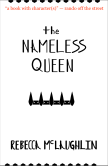 Illustrator is another Adobe program, and you can of course use any other image-designing or drawing program. Or paper, if you desire! I used Illustrator to create placeholder covers for my book (see image to the left). Or I hand-drew them. The important part for me was to create something that proved to me that this could be a real and proper book. Anytime I do NaNoWriMo, I end up with a cover of some kind—mostly hand-drawn, but sometimes computer-drawn. For me, it’s a powerful visualization that compels me to keep working. Before I had access to Illustrator, I used Pixlr, a free online program. You can also use GIMP, another free-source image editing program.
Illustrator is another Adobe program, and you can of course use any other image-designing or drawing program. Or paper, if you desire! I used Illustrator to create placeholder covers for my book (see image to the left). Or I hand-drew them. The important part for me was to create something that proved to me that this could be a real and proper book. Anytime I do NaNoWriMo, I end up with a cover of some kind—mostly hand-drawn, but sometimes computer-drawn. For me, it’s a powerful visualization that compels me to keep working. Before I had access to Illustrator, I used Pixlr, a free online program. You can also use GIMP, another free-source image editing program.
Word Processor Program
Microsoft Word
This is about as industry-standard as you can get for writing. If you send content back and forth to your agent, editor, beta, critique partner, or others, it is 90% likely to be in Microsoft Word. Track changes is the holy grail of collaborative work between writers, and I haven’t found a program that does it better than Word. The downside to word processing programs is that they aren’t good for EVERY part of the writing process. They’re very good for linear work and collaborative commenting. But they fall short in the arena of planning and chaotic thinking. That’s why I use so many other methods of planning and brainstorming and work. This program might be a crucial tool and a holy grail, but it’s not the end-all be-all. I use this program for revisions and communications, but I haven’t even always used it for drafting.
Scrivener
When I drafted THE NAMELESS QUEEN in 2014, it was with this program. I never successfully made it through the tutorial, but I did learn enough to get by. And get by, I did. This program gives you a daily word-count target tracker that you can reset everyday, so it provides a handy visual while you work. It also functions with a virtual corkboard of notecards, which can facilitate character planning or keeping records of details for you story. There’s a lot of bulk within this program, but I sadly switched to a different computer (mac from pc), so I lost my license, which is not transferrable between Operating Systems (OS). So, I don’t know if I’ll use this program for my next book, but we’ll see if i feel like shelling out the 30-some dollars to get a discounted license with my new mac. The good news about this software is that if you do NaNoWriMo, you can get a free temporary license during November (through January, I think), which should give you enough of a taste to see if you like it! Additionally, if you WIN NaNoWriMo, you get a coupon for a discounted license if you want to purchase it. Since I wrote TNQ based on 2014 Nano, that’s how they got me!
Notes on your phone
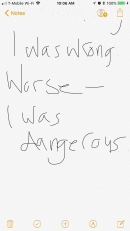 I still haven’t finagled the best solution for taking notes on my phone. There’s a default notes application on my iPhone which talks to my mac, so transferring content between the two is pretty efficient. Also, that app also has a “handwriting” option where you can just DRAW in the notes. That’s pretty hand if you have a stylus or hate the autocorrect that thinks it knows better than you. There’s also Microsoft Word on my phone and a notecards app, and of course access through data/wifi to google drive and other online/cloud storage services.
I still haven’t finagled the best solution for taking notes on my phone. There’s a default notes application on my iPhone which talks to my mac, so transferring content between the two is pretty efficient. Also, that app also has a “handwriting” option where you can just DRAW in the notes. That’s pretty hand if you have a stylus or hate the autocorrect that thinks it knows better than you. There’s also Microsoft Word on my phone and a notecards app, and of course access through data/wifi to google drive and other online/cloud storage services.
Dictation (Recording Device/App)
Ah, here is one of my biggest secrets. I have a 20-minute commute to work everyday, most of it freeway driving. During that 20-minute drive, I will frequently dictate using my iPhone and my microphone-headphones. I. Love. It.
Don’t like hearing your own voice on recordings? Spoiler: no one does. I didn’t like it at first. But! It was just me listening to it, and that made it okay. (Saying nothing about my sporadic YouTube video presence.) I adjusted to it over time—like we do with all things over time. 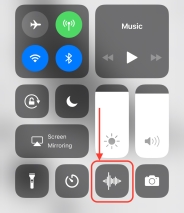 Here’s what I do: I start the basic recording app (I use the default Voice Memos app on my iPhone, which is especially good, since I can add a shortcut from my quick-menu to it). I start driving, and I just TALK to myself. Sometimes this involves me complaining about writer’s block or being stuck. Mostly, I just launch into a monologue or a conversation between characters, and I just talk my way through the scene. You have to be okay with the fact that it’s awkward and that most of it will suck. At the end of the day, I spend about 40-60 minutes typing up a 20 minute dictation, and it is SO productive. I write more this way than I do if I waste an hour staring at a blank page. I can’t recommend it highly enough! Though, do be safe and present while driving. I missed my exit a few times over the past year, and while it made for a fun story, it was also not so great to listen to myself struggle to not use copious swear words while I fumbled my way back to the freeway.
Here’s what I do: I start the basic recording app (I use the default Voice Memos app on my iPhone, which is especially good, since I can add a shortcut from my quick-menu to it). I start driving, and I just TALK to myself. Sometimes this involves me complaining about writer’s block or being stuck. Mostly, I just launch into a monologue or a conversation between characters, and I just talk my way through the scene. You have to be okay with the fact that it’s awkward and that most of it will suck. At the end of the day, I spend about 40-60 minutes typing up a 20 minute dictation, and it is SO productive. I write more this way than I do if I waste an hour staring at a blank page. I can’t recommend it highly enough! Though, do be safe and present while driving. I missed my exit a few times over the past year, and while it made for a fun story, it was also not so great to listen to myself struggle to not use copious swear words while I fumbled my way back to the freeway.
Graphs & Data
Data is a beautiful thing. *swoon* You can use it to track anything you want. I typically use Excel, unless I want an auto-generated histogram, in which case I use Google Sheets. As far as drafting is concerned, Nanowrimo typically provides you with a data input and graph log system. But that only gets you as far as the end of the month of November. I love creating graphs to help me track my work. It’s good for words per day when drafting, and then pages per day for revisions. Also, you can gather data about your own writing habits, such as hours per day, words typed per day, words removed, etc. in order to get a breakdown of your own writing habits.
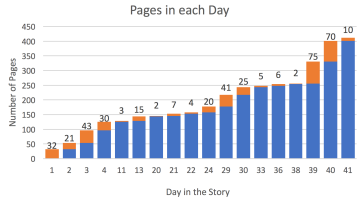
You can use all kinds of data breakdowns to answer questions, such as: how many female vs. male characters are in the book? How many of those characters have names, or are in positions of power, or die? How many chapters do you have, and how much time does each take up? The example I’ve included is from an early draft of my book, THE NAMELESS QUEEN, and you can see that my time management skills are not *the best.* It did get better in later drafts. A bit better. But making this graph and others helped give me a high level perspective on the logistics of the story. I strongly encourage to any kind of data breakdown you think will help you gain a new perspective on your story.
What About You?
The biggest thing for me is trying new things when my current habits stop working. I admire those weird stories of authors and artists who have such a reliable and regular routine, that it works for them for years. For me, I’m still figuring it all out. I do what works until it doesn’t work anymore. And when something doesn’t work, you try something else!
So if you have any tools, tips, or tricks that you use, let me know! (My first draft of this post was initially 1k words longer, but WordPress screwed up and lost a bunch of my progress, so it’s possible I’ve forgotten some items.)
